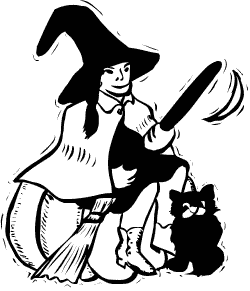Which Witches?
 Since humans have started recording our thoughts with handprints on cave walls, magic and ritual have been a part of our collective cultural consciousness. As such, most cultures around the world have folklore that is loosely about 'witches'. Western European and Euro-American have acquired a particularly recognisable set of tropes, myths, and trails of historical misinformation.
Since humans have started recording our thoughts with handprints on cave walls, magic and ritual have been a part of our collective cultural consciousness. As such, most cultures around the world have folklore that is loosely about 'witches'. Western European and Euro-American have acquired a particularly recognisable set of tropes, myths, and trails of historical misinformation.Historically, witchcraft in European culture was something to be feared. It was also a convenient catch-all explanation for crop failures, diseases, household accidents and general bad luck. The idea that witches were lurking about (and thus a public menace that needed to be addressed) was also an easy way to topple political enemies, religious dissidents, business rivals, or someone whose belongings one wanted to claim as 'reparations' for being cursed. By the 18th century, belief in witches and witchcraft had eroded to the point that anti-witchcraft laws were replaced by laws that would punish self-identified witches for fraud. However, popular opinion on the matter still skewed towards the possible existence of evil magic, and the negative connotation around witchcraft persisted.
It's not until the 20th century that witches have turned into the protagonists in Western popular culture*. The trope has now gotten a foothold to the point where any magic users in the story will likely be the protagonists; any magic-wielding villains are likely to be fought by more magic users.
Interestingly, as witches lost the automatic connection to evil, they also lost their connection to the idea that magic has a price. While I'm glad that the idea of witches as automatically evil has retired, it seems like a missed plot development and worldbuilding opportunity to have magic be a total freebie. Consider some throwback to the pre-Sabrina tropes that make witches flirt with danger every time they cast a spell.
*Specificity is key here; there's a whole blog series to be gotten out of attitudes towards magic and witchcraft in different cultures. Maybe next October?
Published on October 29, 2014 02:57
No comments have been added yet.



